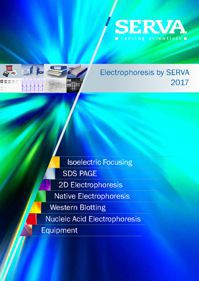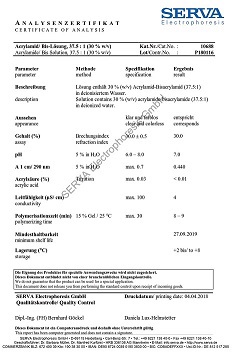Cetyltrimethylammonium bromide
Cetyltrimethylammonium bromide (CTAB) is a cationic surfactant with a wide range of applications. It is mentioned in numerous publications as being suitable for the isolation of DNA.
It is an effective surfactant for cell permeabilization. The CTAB method is of particular interest in the permeabilization of lactase-rich cells; this application is of great utility in enzymatic hydrolysis of lactose, an important food-processing reaction.
Reverse micellar systems with CTAB offer new possibilities for enzyme chemistry in non-polar solvents, e.g. for the investigation of malate dehydrogenase, lactate dehydrogenase and chloroperoxidase.
Cetyltrimethylammonium bromide enhances the fluorescence of biochemically relevant compounds and increases the efficiency of chemiluminescence reaction. An excellent example of the latter is the luminol reaction that is important in the determination of glucose in blood serum.
CTAB has proved of value in PAGE and as a modifier in a number of chromatographic systems
Synonyms: Cetrimonium bromide, CTAB, Hexadecyltrimethylammonium bromide
CAS-registry number: [57-09-0]
Molecular formula: C19H42N+Br-
Relative molecular mass (Mr): 364.5
Classification: Cationic surfactant
Literature specifications:
• Critical micellar concentration (CMC): 0.92 mM
• Aggregation number (Na): 61
• Krafft point (TK): 22 °C
Bibliography
Isolation of DNA and Oligonucleotides
Del Sal, G., Manfioletti, G. a. Schneider, C. (1988) A one-tube plasmid DNA mini-preparation suitable for sequencing. Nucleic Acids Res. 16, 9878.
Cummings, B. a. Wood, T. (1989) A simple and efficient method for isolating genomic DNA from endomycorrhizal spores. Gene Anal. Tech. 6, 89-92.
Del Sal, G., Manfioletti, G. a. Schneider, C. (1989) The CTAB-DNA precipitation method: a common mini-scale preparation of template DNA from phagemids, phages or plasmids suitable for sequencing. BioTechniques 7, 514-8, 520.
Jost, J.P., Jiriicny, J. a. Saluz, H. (1989) Quantitat¬ive precipitation of short oligonucleotides with low concentrations of cetyltrimethylammonium bromide. Nucleic Acids Res. 17, 2143.
Machii, H. (1989) Isolation of total mulberry DNA. Nippon Sanshigaku Zasshi 58, 349-50.
Milligan, B.G. (1989) Purification of chloroplast DNA using hexadecyltrimethylammonium bro¬mide. Plant Mol. Biol. Rep. 7, 144-9.
Sandbrink, J.M., Vellekoop, P., Van Ham, R. a. Van Brederode, J. (1989) A method for evolu¬tionary studies on RFLP of chloroplast DNA, applicable to a range of plant species. Bio¬chem. Syst. Ecol. 17, 45-9.
Smith, G.L.F., Sansone, C. a. Socransky, S.S. (1989) Comparison of two methods for the small-scale extraction of DNA from subgingival microorganisms. Oral Microbiol. lmmunol. 4, 135-40.
Khanuja, S.P.S. et al. (1999) Rapid isolation of DNA from dry and fresh samples of plants producing large amounts of secondary metabolites and essential oils. Plant Mol. Biol. Rep. 17, 1-7.
v. Ginkel, F.W. et al. (2003) Pneumococcal carriage results in ganglioside-mediated olfactory tissue infection. PNAS 100, 14363-7.
Sharma, R. et al. (2003) Isolating plant genomic DNA without liquid nitrogen. Plant Mol. Biol. Reporter 21, 43-50.
de Hoog, G.S. et al. (2007) Molecular analysis and pathogenicity of the Cladophialophora carrionii complex, with the description of a novel species. Stud. Mycol. 58, 219-34.
Karcher, D. a. Bock, R. (2009) Identification of the chloroplast adenosine-to-inosine tRNA editing enzyme. RNA 15, 1251-7.
Tembe, R.P. a. Deodhar, M.A. (2010) Chemical and molecular fingerprinting of different cultivars of Pelargonium graveolens (L´Herit.) viz., Reunion, Bourbon and Egyptian. Biotechnology 9, 485-91.
Isolation of RNA
Jaakola, L. et al. (2001) Isolation of high-quality RNA from bilberry (Vaccinium myrtillus L.) fruit. Mol. Biotech. 19, 201-3.
Ahlert, D. et al. (2003) Plastid protein synthesis is required for plant development in tobacco. PNAS 100, 15730-5.
Gasic, K. et al. (2004) RNA extraction from different apple tissues rich in polyphenols and polysaccharides for cDNA library construction. Plant Mol. Biol. Reporter 22, 437a-437g.
Tattersall, E.A.R. et al. (2005) Comparison of methods for isolating high-quality RNA from leaves of grapevine. Am. J. Enol. Vitic. 56, 400-6.
Gambino, G. et al. (2008) A rapid and effective method for RNA extraction from different tissues of grapevine and other woody plants. Phytochem. Anal. 19, 520-5.
Permeabilization of Cells
Jackson, J.H. (1988) Rapid assay of acetolactate synthase in permeabilized bacteria. Methods Enzymol. 166, 230-3.
Joshi, M.S., Bachhawat, N. a. Bhat, S.G. (1989) Stabilization of cetyltrimethylammonium bromide permeabilized yeast whole cell lac¬tase. Biotechnol. Lett. 11, 349-52.
Sekhar, S. et al. (1999) Preparation of detergent permeabilized bakers yeast whole cell catalase. Process Biochem. 34, 349-54.
Manocha, G. a. Gaikar, V.G. (2006) Permeabilization of Aspergillus niger by reverse micellar solutions and simultaneous purification of catalase. Sep. Sci. Technol. 41, 3279-96.
Kaur, G. et al. (2009) Hydrolysis of whey lactose using CTAB-permeabilized yeast cells. Bioproc. Biosys. Engineer. 32, 63-7.
Solubilization of Enzymes in Reverse Micelles
Franssen, M.C.R., Weijnen, J.G.J., Vincken, J.P., Laane, C. a. Van der Plas, H.C. (1988) Chloro¬peroxidase-catalyzed halogenation of apolar compounds using reversed micelles. Bio-catalysis 1, 205-16.
Katiyar, S.S., Awasthi, A.K. a. Kumar, A. (1988) Reverse micelles as a versatile medium for the study of lactate dehydrogenase in vitro. Bio¬chem. Int. 17, 1165-70.
Katiyar, S.S., Kumar, A. a. Kumar, A. (1988) Behavior of enzymes in reverse micelles in non-aqueous solvents. Proc. Indian Natl. Sci. Acad., Part. A 54, 711-6.
Krei, G.A. a. Hustedt, H. (1992) Extraction of enzymes by reverse micelles. Chem. Engineer. Sci. 47, 99-111.
Akama, K. et al. (1994) Purification and characterization of a novel acrosin-like enzyme from boar cauda epididymal sperm. J. Biochem. 116, 464-70.
Sivasamy, A. et al. (2005) Effects of nonpolar solvents on the solubilization of pepsin into bis(2-ethylhexyl) sodium sulfosuccinate and cetyltrimethylammonium bromide reverse micelles. J. Solution Chem. 34, 33-42.
Das, D. et al. (2008) Improved activity of enzymes in mixed cationic reverse micelles with imidazolium-based surfactants. Biochimie 90, 820-9.
Feitosa, E. et al. (2008) Phase diagrams of a CTAB/organic solvent/buffer system applied to extraction of enzymes by reverse micelles. J. Chromatogr. B 882, 58-63.
Nandini, K.E. a.Navin, K. Rastogi (2009) Reverse micellar extraction for downstream processing of lipase: Effect of various parameters on extraction. Process Biochem. 44, 1172-78.
Kolisis, F.N. a. Stamatis, H. (2010) Reverse Micelles, Enzymes. Encyclopedia of Industrial Biotechnology: Bioprocess, Bioseparation, and Cell Technology. 1-28. John Wiley & Sons, Inc..
Bo Zhou et al. (2012) Effect of chaotropes in reverse micellar extraction of kallikrein. Process Biochem. 47, 229-33.
Reverse Micellar Extraction of Peptides and Proteins
Leser, M.E. a. Luisi, P.L. (1989) Liquid 3-phase micellar extraction of peptides. Biotechnol. Tech. 3, 149-54.
Forney, C.E. a. Glatz, C.E. (1995) Extraction of charged fusion proteins in reversed micelles: Comparison between different surfactant systems. Biotechnol. Prog. 11, 260-4.
Chemiluminescence/Fluorescence Applications
Abdel-Latif, M.S. a. Guilbault, G.G. (1989) Perox¬ide optrode based on micellar-mediated chemi¬luminescence reaction of luminol. Anal. Chim. Acta 221, 11-17.
Shimomura, 0. (1989) Chemiluminescence of panal (a sesquiterpene) isolated from the lumi-nous fungus Panellus stipticus. Photochem. Photobiol. 49, 355-60.
Aiken, J.H. a. Huie, C.W. (1991) Detection of bili¬rubin using surfactant fluorescence enhance¬ment and visible laser fluorometry. Anal. Lett. 24, 167-80.
Memoli, A. et al. (1994) Effects of surfactants on the spectral behaviour of calcein. J. Pharm. Biomed. Anal. 12, 307-12.
Matzinger, S. et al. (1998) Fluorescent probe solubilization in the headgroup and core regions of micelles : fluorescence lifetime and orientational relaxation measurements. J. Physic. Chem. 102, 7216-24.
Ramos-Lledo, P. et al. (2001) Determination of vitamin A and E in milk samples by fluorescence in micellar media. Fresenius J. Anal. Chem. 369, 91-95.
Huang, C. et al. (2007) Sensitization of surfactants on the chemiluminescence reaction of fluorescein isothiocyanate labelled proteins. J. Biochem. Biophys. Methods 70, 341-7.
Huang, C.-B. et al. (2010) On-line flow-injection chemiluminescence determination of bovine serum albumin using surfactant-enhanced dichlorofluorescein-hypochlorite system. Anal. Lett. 43, 2275-82.
Chromatographic and Electrophoretic Separations
Nakajima, T. et al. (1984) Structure of the cell wall proteogalactomannan from Neurospora crassa. I. Purification of the proteoheteroglycan and characterization of the alkali-labile oligosaccharides. J. Biochem. 96, 1005-11.
Canas, M.B., lmaz, V.C., lzquierdo, H.R.C. a. Polo Diez, L. (1988) Determination of pterins in urine by high-performance liquid chromatogra¬phy on C18 columns conditioned with cetyltri-methylammonium bromide. J. Chromatogr. 458, 217-23.
Junker-Buchheit, A. a. Jork, H. (1988) Urinary porphyrins: ion-pair chromatography and fluorometric determination. J. Planar Chroma¬togr. - Mod. TLC 1, 214-9.
Kasper, T.J.., Melera, M., Gozel, P. a. Brownlee, R.G. (1988) Separation and detec¬tion of DNA by capillary electrophoresis. J. Chromatogr. 458, 303-12.
Liu, J., Banks, J.F. Jr. a. Novotny, M. (1989) High¬speed micellar electrokinetic capillary chroma¬tography of the common phosphorylated nucleosides. J. Microcolumn Sep. 1, 136-41.
Akins, R.E. a. Tuan, R.S. (1994) Separations of proteins using cetyltrimethylammonium bromide discontinuous gel electrophoresis. Mol. Biotechnol. 1, 211-28.
Ding. W. a. Frit, J.S. (1997) Separation of basic proteins and peptides by capillary electrophoresis using a cationic surfactant. J. High Resol. Chromatogr. 20, 575-80.
Körs, M. a. Steinhart, H. (1997) CTAB electrophoresis and immunoblotting: a new method fort the determination of soy protein in meat products. Z. Lebensm. Unters. Forsch. A 205, 224-6.
Buxbaum, E. (2003) Cationic electrophoresis and electrotransfer of membrane glycoproteins. Anal. Biochem. 314, 70-6.
Simpson, R.J. (2010) CTAB-PAGE. Cold Spring Harb, Protoc. 2010: pdb.prot5412.
Further Applications
Maguire, R.B., Nadakavukaren, M.J. a. Tsang, J.C. (1988). Studies on the effect of detergent treat¬ment on the cell envelope polysaccharide components of Serratia marcescens 08 by the periodic acid-thiosemicarbazide-silver proteinate technique. Microbios Lett. 39, 25-32.
Rosing, J., Tans, G., Speijer, H. a. Zwaal, R.F.A. (1988) Calcium-independent activation of prothrombin on membranes with positively charged lipids. Biochemistry 27, 9048-55.
Pinnaduwage, P., Schmitt, L. a. Huang, L. (1989) Use of a quaternary ammonium detergent in liposome mediated DNA transfection of mouse L-cells. Biochim. Biophys. Acta 985, 33-7.
Zalisz, R. a. Salles, M.F. (1989) Preparation of a water-soluble acylglycoprotein from Klebsiella as allergy inhibitor. U.S. US 4.870.053.
Lindstedt, M. et al. (1990) Antimicrobial activity of betaine esters, quaternary ammonium amphiphiles which spontaneously hydrolyze into non-toxic components. Antimicrobial Agents and Chemotherapy 34, 1949-54.
Seno, M., Shiraishi, Y., Takeuchi, S. a. Otsuki, J. (1990) Transport of fatty acids facilitated by n-hexadecyltrimethylammonium bromide micelles through a liquid membrane. J. Phys. Chem. 94, 3776-80.
Martellaro, P.J. et al. (2001) Environmental application of mineral sulfides for removal of gas-phase Hg(0) and aqueous Hg2+. Sep. Sci. Technol. 36, 1183-96.
Xiangju Meng et al. (2007) Synthesis and characterization of chiral periodic mesoporous organosilicas. Angew. Chemie 119, 7942-4.
Asim, N. et al. (2009) Preparation of WO3 nanoparticles using cetyl trimethyl ammonium bromide supermolecular template. Am. J. Applied Sciences 6, 1424-8.
Yang QuiHua et al. (2010) Functionalized periodic mesoporous organosilicas : hierarchical and chiral materials. Sci. China Cem. 53, 351-6.






